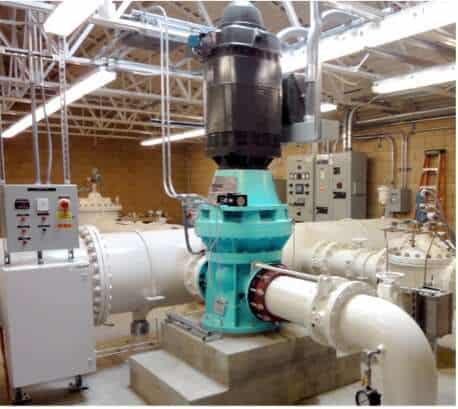
Millions of miles of pipelines and conduits across the United States make up an intricate network of waterways used for municipal, agricultural and industrial purposes.
In a new report, researchers at the U.S. Department of Energy’s Oak Ridge National Laboratory have found potential opportunities in all 50 states to efficiently utilize existing infrastructure to harvest this otherwise wasted energy.
In a first-of-its-kind analysis, ORNL estimates that conduit hydropower, which uses water from structures such as water supply pipelines and irrigation canals, has the potential to add 1.41 gigawatts of electricity to the country’s power grid—enough to power more than a million homes.
“You can think of conduit hydropower as low-hanging fruit, and what has been started is a mere drop in the bucket,” said Shih-Chieh Kao, water power program manager at ORNL. “For all its benefits, the biggest barrier is a general lack of awareness of conduit hydropower’s potential.”
The process for municipalities and other stakeholders to develop conduit hydropower would be relatively easy. Without the need to build new dams, facility operators could install hydropower generators at locations with excess hydraulic head—the height of water needed for hydropower generation. This could be coordinated with planned facility upgrades that replace aging infrastructure with more energy-efficient systems. Rural communities may benefit by adding small hydropower generation to their existing infrastructure for net metering, making them less dependent on the external grid.
Since conduit hydropower taps into existing infrastructure with minimal environmental impacts, the permitting process has been streamlined. Through the Hydropower Regulatory Efficiency Act of 2013 and its amendments in America’s Water Infrastructure Act of 2018, the federal regulatory approval process can be completed in 45 days. To date, more than 350 conduit hydropower projects have been permitted or constructed, with more to come.
Opportunities by state
Scientists at ORNL conducted a systematic analysis of four types of conduits—water supply pipelines, wastewater discharge, irrigation systems and thermoelectric cooling water discharge.
For conduit hydropower to work, the water channel must have sufficient water flow and hydraulic head. Scientists analyzed this data as well as satellite imagery and topography to estimate the overall potential.
The potential for conduit hydropower was highest in five Western states—California, Colorado, Washington, Nebraska and Oregon—all of which have a large number of water conduits. Their hilly terrain also provides the greatest hydraulic head.
Agricultural conduits such as ditches and channels for crop irrigation showed the greatest potential for hydropower among the three business sectors assessed, amounting to nearly half of all conduit hydropower capacity. The highest agricultural conduit potential was seen in Colorado, Washington, Nebraska, California, Oregon and Idaho. Irrigation and topography were primary drivers for this assessment.
Researchers also assessed drinking water supply and wastewater systems in the municipal sector. Conduit hydropower potential here was highest in California, which had twice that of the next-highest state, New York. Colorado, Utah, Washington, Oregon and Pennsylvania also showed potential for capacity generation in this sector.
Opportunities for conduit hydropower from industrial conduits, such as industrial pipelines or canals used at thermoelectric generating facilities, were present mostly in California, Texas, Missouri, New York and Maryland. However, these facilities also pose the greatest uncertainty due to higher economic and regulatory requirements.
“These assessments open the door across multiple business sectors to what is possible,” said Kao. “By further understanding the costs and benefits of conduit hydropower, decision makers can leverage what is already available and deliver on the promise of more renewable energy.”
The ORNL research team will facilitate further discussion with key stakeholders in water supply and delivery to raise the awareness of conduit hydropower and to understand how the community may overcome this hurdle to develop more conduit hydropower projects.























